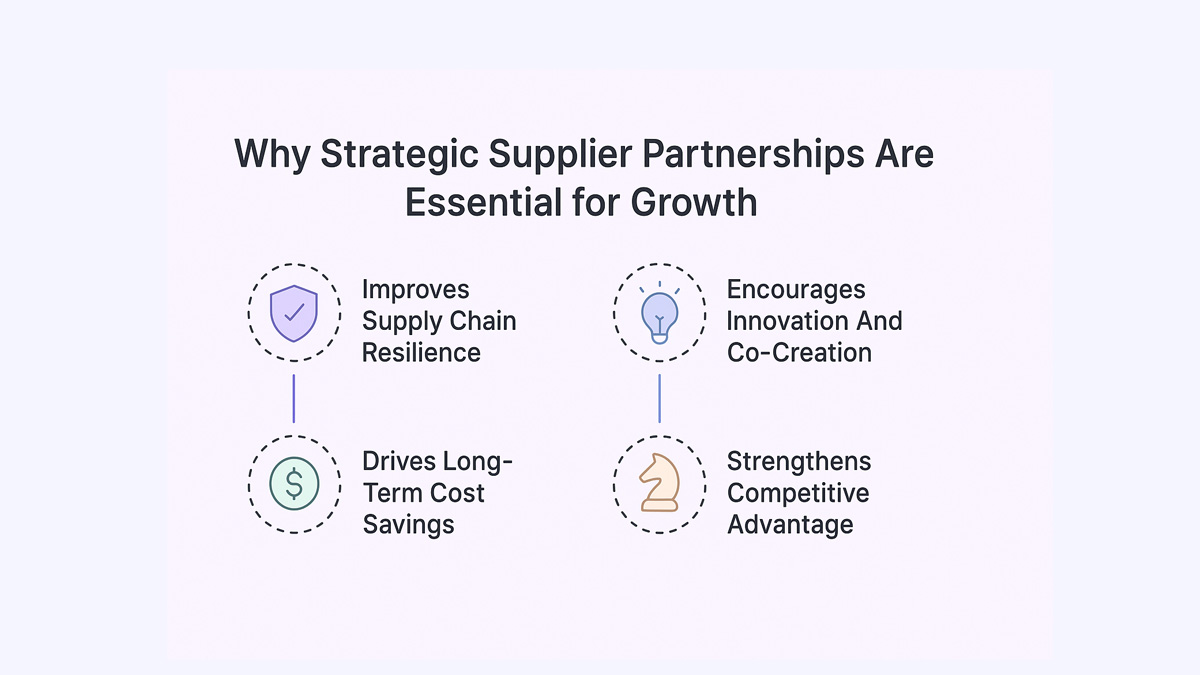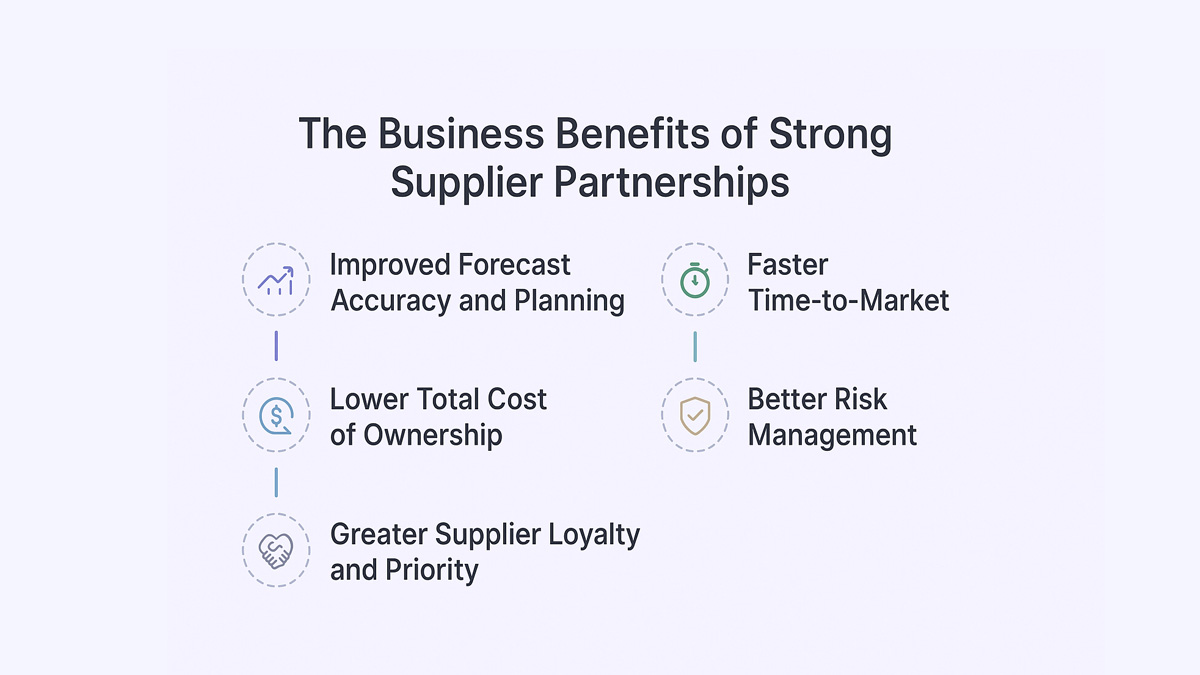

What Happens When You Stop Treating Suppliers Like Vendors?

What Happens When You Stop Treating Suppliers Like Vendors?
Learn how to build strategic supplier partnerships that drive innovation, reduce risk, and unlock long-term business value.


According to Deloitte, nearly 60% of companies face supply chain disruptions each year, often losing millions due to weak supplier visibility. As businesses grow more dependent on global vendors and complex SaaS ecosystems, treating suppliers as transactional partners is no longer sustainable. It’s time to talk about how strategic supplier relationships can reduce risk, boost efficiency, and drive long-term growth.
What is Strategic Supplier Partnership?
A strategic supplier partnership is a long-term, collaborative relationship between a company and its suppliers based on shared goals, trust, and transparency. Instead of focusing only on price and delivery, it drives mutual growth, innovation, and problem-solving for better supply chain performance.
Why Strategic Supplier Partnerships Are Important
Strategic supplier partnerships go beyond the simple exchange of goods and services. They act as a cornerstone for building resilience, agility, and innovation across the supply chain. When businesses and suppliers align closely, they can anticipate challenges together and respond faster, creating a win-win for both sides. Here’s why these partnerships matter:

Improves Supply Chain Resilience
By working closely with suppliers, companies can spot potential disruptions early and plan for contingencies. Shared forecasts and inventory planning create a buffer against supply shortages or shipping delays, minimizing the impact on customers.
Drives Long-Term Cost Savings
Strategic partnerships encourage joint cost-optimization initiatives such as bulk purchasing, process improvements, and shared logistics. These efforts lead to measurable cost efficiencies across the value chain. Over time, this can lead to better pricing, reduced operational inefficiencies, and stronger margins.
Encourages Innovation And Co-Creation
When suppliers are treated as partners rather than vendors, they’re more willing to share ideas, technology, and expertise. This co-creation can lead to new products, improved designs, or faster time-to-market advantages. Leveraging supplier expertise early in the process often unlocks smarter product innovations.
Strengthens Competitive Advantage
A stable, trustworthy supplier base allows businesses to differentiate themselves. These partnerships are designed to deliver long-term value rather than short-term gains. From consistent quality to exclusive agreements, partnerships provide advantages that competitors relying on transactional relationships simply don’t have. This is especially crucial for businesses sourcing critical raw materials where reliability is non-negotiable.
7 Essential Attributes of Strategic Supplier Partnerships
Strong supplier relationships go beyond contracts and cost negotiations. They’re built on mutual trust, shared goals, and a long-term commitment to success. Strategic supplier partnerships allow both sides to innovate, reduce risk, and create sustainable value across the supply chain. Here are the seven essential attributes of strategic supplier partnerships that define lasting success.
1. Shared Vision & Strategy
A shared vision keeps both partners moving in the same direction. When suppliers and companies align on future goals like sustainability, innovation, or market expansion they can make faster decisions and invest confidently. This strategic alignment ensures every action supports a common purpose, strengthening the relationship over time.
2. Shared Values
Shared values form the foundation of any strong partnership. They reflect how each party conducts business, treats people, and makes ethical decisions. When both sides prioritize integrity and transparency, collaboration becomes easier, challenges are addressed openly, and the partnership earns credibility within and beyond the organization.
3. Shared Investment & Risk
True partnerships require shared responsibility. Both companies and suppliers should invest resources, time, money, and expertise toward joint projects or innovations. By sharing risks and rewards, they strengthen trust and motivation. This approach also encourages each side to commit fully, knowing that success or failure impacts both equally.
4. Shared Planning & Management Systems
Integrated systems make collaboration seamless. Shared planning platforms, data dashboards, and performance tools enable real-time visibility across the supply chain. When both sides rely on the same technology and information, it reduces duplication, improves forecasting accuracy, and helps teams react faster to changes or disruptions.
5. Open and Consistent Communication
No partnership thrives without honest communication. Regular updates, feedback sessions, and business reviews keep both teams informed and aligned. Open communication also helps identify potential issues before they escalate, making it easier to find solutions quickly and maintain trust.
6. Continuous Improvement
High-performing partnerships never stay static. Both sides should review performance metrics, identify inefficiencies, and set goals for improvement. Whether it’s reducing lead times, improving product quality, or enhancing sustainability practices, continuous improvement keeps the relationship evolving and competitive.
7. Performance Measurement and Accountability
Shared success requires clear metrics. Defining KPIs around cost savings, quality, delivery timelines, and innovation ensures accountability. Regularly measuring progress against these goals helps both sides stay focused on outcomes that deliver real business impact.
Benefits Of Strategic Supplier Partnerships
Long-term supplier partnerships bring more to the table than just consistency. They open doors to strategic gains that ripple across every corner of the business. Here’s how companies benefit from moving beyond transactional relationships:

Improved Forecast Accuracy And Planning
With aligned demand forecasts and shared inventory data, both sides can plan more precisely. This reduces stockouts, excess inventory, and reactive firefighting.
Faster Time-To-Market
Partners who collaborate from day one on product development can shorten design cycles and spot issues early - helping companies launch faster and smarter.
Lower Total Cost Of Ownership
Beyond price per unit, strategic partnerships reduce costs related to quality issues, delays, and inefficiencies. Consistent quality control is easier to enforce when suppliers are involved in early-stage collaboration. The result? Better value across the lifecycle of a product or service.
Better Risk Management
Trusted suppliers are more likely to flag potential disruptions early. This proactive approach supports broader risk management efforts across the supply chain. Joint planning enables quicker mitigation strategies, reducing the impact of supplier-side issues.
Greater Supplier Loyalty And Priority
In competitive supply markets, strategic partners often get preferential treatment - from capacity allocation to early access to innovation. This can give companies a crucial edge during crunch periods.
How To Build Strategic Supplier Partnerships
Creating a strategic supplier partnership doesn’t happen overnight. It requires deliberate planning, mutual respect, and ongoing collaboration. Here’s how to build one effectively:
Start With Clear Alignment On Goals
Both parties should understand and agree on shared objectives. This could include sustainability targets, innovation goals, or cost-reduction metrics. Clear alignment creates a strong foundation for collaboration.
Invest In Transparent Communication
Regular check-ins, data sharing, and honest discussions about challenges build trust. Transparency ensures both parties can adjust quickly to market shifts and keep expectations realistic. This is a key pillar for building strong vendor relationships that can scale with your business.
Build Mutual Trust And Accountability
Trust grows from reliability and fairness. Set clear responsibilities, deliver on promises, and recognize your supplier’s contributions. Over time, accountability strengthens the partnership.
Measure Performance Collaboratively
Use joint KPIs and scorecards to monitor performance. Instead of using metrics as a “stick,” use them as a shared tool to drive improvement and celebrate success.
How to Transition from Transactional to Strategic Partnership
Most supplier relationships start as transactional focused on pricing, delivery, and basic compliance. But to drive long-term business impact, companies must shift toward partnerships built on trust, shared goals, and innovation. Here’s a simple framework to help you transition from transactional to strategic supplier partnerships.
1. Identify Your Strategic Suppliers
Not every vendor qualifies as a strategic partner. Begin by identifying suppliers with high spend impact, operational risk, or strong innovation potential. These are the relationships that can influence your organization’s competitive advantage. Evaluate them based on financial importance, supply chain dependency, and their ability to collaborate on long-term goals.
2. Establish Mutual Objectives & Joint KPIs
A strategic partnership requires shared objectives beyond cost savings. Define joint KPIs that measure outcomes such as product quality, innovation, sustainability, and process efficiency. Setting clear goals ensures both parties remain aligned and accountable, turning vendor management into a collaborative growth strategy.
3. Align Stakeholders & Resources
Transitioning to a strategic model demands internal alignment. Bring procurement, finance, operations, and leadership teams together to support the initiative. Formalize commitments through governance structures, shared planning sessions, and clear communication channels. This ensures every department works toward the same partnership objectives.
4. Build Mutual Trust & Transparency
Trust transforms supplier relationships. Encourage open data sharing on forecasts, costs, and performance metrics. Transparency builds confidence, speeds up decision-making, and helps both sides anticipate challenges early. Regular reviews and honest communication help maintain a balanced, reliable relationship over time.
Implementing A Supplier Relationship Management (SRM) Strategy
Strong supplier relationships don’t just happen, they’re built on structure and intent. A clear Supplier Relationship Management (SRM) strategy gives you a framework to manage, evaluate, and grow partnerships that truly impact your business. It ensures that every supplier relationship, from tactical to strategic, contributes to performance and innovation.
Below are the key steps to build and implement an effective SRM approach.
Step 1: Segment Suppliers and Define Engagement
The foundation of any SRM strategy is to segment your suppliers. This process, known as supplier segmentation, helps you decide where to focus your time and resources. Not all vendors need the same level of attention, some drive business-critical outcomes, while others simply keep operations running smoothly.
Use a simple matrix to categorize suppliers into three tiers:
- Critical suppliers: High-spend or high-impact partners that influence your organization’s strategy, risk profile, or innovation potential. Strategic partnerships should be built exclusively with this segment.
- Tactical suppliers: Partners that support key functions but aren’t central to innovation. Manage them through performance reviews and periodic check-ins.
- Transactional suppliers: Low-risk vendors providing standardized goods or services. Manage them efficiently through automated systems.
Step 2: Define Clear Governance Models
Once you know where each supplier fits, formalize how you’ll work together. Governance models outline who owns each relationship, how decisions are made, and how issues are resolved. Defined roles, escalation paths, and review schedules ensure consistency especially for cross-functional or global teams managing the same supplier.
Step 3: Set Up Collaborative Performance Metrics
A strong SRM program is built on measurable outcomes. Establish shared KPIs that go beyond price and delivery timelines. Track progress on innovation goals, sustainability initiatives, and operational efficiency. These joint metrics create accountability and encourage continuous improvement across both teams.
Step 4: Schedule Regular Business Reviews
Frequent check-ins keep partnerships aligned and productive. Quarterly or biannual business reviews help assess performance, identify risks, and plan for the future. Use these sessions to celebrate progress, address challenges early, and realign objectives when business priorities shift.
Step 5: Use Technology to Strengthen Collaboration
Technology turns SRM from a manual process into a connected ecosystem. Use digital SRM tools to centralize contracts, track performance, and streamline communication. Self-service portals give suppliers visibility into data and updates, improving transparency and reducing administrative overhead.
Modern SRM platforms also help cross-functional teams collaborate more effectively ensuring procurement, finance, and operations all work from the same source of truth.
Leveraging Technology To Deepen Supplier Collaboration
Technology has become the secret sauce in modern supplier partnerships. Without it, collaboration often gets stuck in email chains and spreadsheet chaos. With it, teams can align in real-time, make data-driven decisions, and stay agile in the face of shifting demands.
Procurement platforms, for example, allow both suppliers and buyers to share forecasts, track order statuses, and manage contracts in a single source of truth. Cloud-based tools break down silos, giving everyone access to the same information at the same time. A centralized supplier portal can simplify communication and ensure consistency in documentation. Automation also plays a role - streamlining approvals, flagging exceptions, and reducing errors that often strain relationships.
Beyond the basics, advanced analytics and AI now help businesses evaluate supplier risk, performance, and pricing trends with greater accuracy. This transparency fosters trust - and makes room for continuous improvement on both sides of the table.
How Spendflo Helps With Strategic Supplier Partnerships
When supplier data is scattered and renewals slip through the cracks, even the best procurement teams struggle to stay strategic. That’s where Spendflo steps in.
Companies like Acumatica and Reveal Data use Spendflo to turn chaotic vendor management into a unified, data-driven process. With complete visibility into contracts, renewals, and pricing benchmarks, their teams gained control over spend and built lasting supplier partnerships that drive measurable ROI.
If your procurement process still runs on manual tracking and fragmented tools, it’s costing you more than just time, it's costing you strategic opportunities. Spendflo helps you centralize supplier management, align stakeholders, and ensure every vendor relationship delivers real value.
Ready to build stronger, smarter supplier partnerships? Book a free demo with Spendflo today.
Frequently Asked Questions on strategic supplier partnerships
What are the key elements of a strategic supplier partnership?
Trust, transparency, aligned goals, and mutual investment are foundational. These relationships also rely on shared data, joint performance reviews, and long-term commitment from both parties.
How can businesses identify the right strategic suppliers?
Look for suppliers that align with your business goals, offer innovation potential, and have a proven track record of reliability. Consider their scalability, financial health, and willingness to collaborate.
What’s the difference between a supplier and a strategic partner?
A supplier fulfills orders. A strategic partner contributes to your long-term success - through innovation, flexibility, and shared accountability. The relationship is proactive, not reactive.
Can technology help improve supplier partnerships?
Absolutely. Tools like Spendflo offer transparency, streamline communications, track performance, and automate workflows - all of which are crucial for building and sustaining high-value partnerships.










.png)




.png)










.avif)





